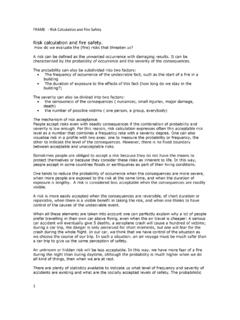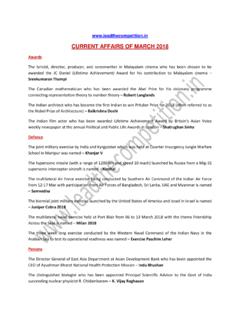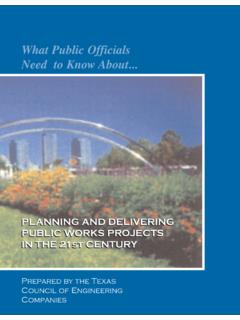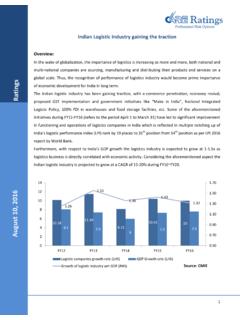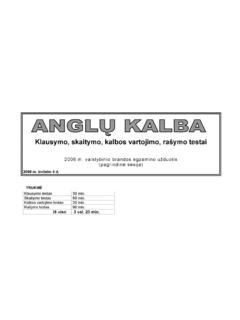Transcription of THE DUSSELDORF AIRPORT FIRE OF APRIL 11, 1996.
1 DUSSELDORFAIRPORT fire -FRAME ANALYSIS1 THE DUSSELDORF AIRPORT fire OF APRIL 11, the NFPA report :During the worst fire in the history of D sseldorf and the incident with the highest loss of lifein the Federal Republic of Germany sincethe end of World War 2,17 civilians died, 72 peoplesuffered serious injuries, and several hundred people suffered minor injuries. The cost of thedamage is still not completely known, as some areas of the AIRPORT have not been restoredto full vary between 300 million and 1 billion German Marks(approximately $200 million to $600 million).A massive operation by the different fire Departments supported by the Police Department,the German Border Police, and other organizations prevented any higher loss of civilianlives, as well as any loss of responding personnel. The situation that the advancingemergency services encountered was made extremely difficult by large clouds ofimpenetrable smoke, as well by as the complex layout ofthe 2000 civilians were rescued from highest danger inside the AIRPORT .
2 AIIavailable aerial trucks, ground ladders, and other rescue equipment were used. AII searchand rescue operations had to be carried out by personnel wearing heavy protectiveequipment, some with extended-wear SCBA. After the suppression of the fire , acomprehensive review of the structures and their plans was made by the fire the same time that some fire fighters were concentrating on saving human lives, otherpersonnel were engaged in a massive fire suppression effort. Several big lines and attacklines as well as foam concentrate were used, with special attention paid to extinguishingburning rubber luggage belts that gave off thick, acridsmoke. The fire fighting forces werehampered both by the complex layouts of the AIRPORT and by extraordinary the AIRPORT fire brigade and the municipal fire service in this massive rescue andfire suppression effort were the departments of several other nearby cities, towns, the initial phase of the incident, a large number of victims suffering from smokeinhalation were triaged and treated at the location.
3 This effort was supported by numeroustrauma physicians, paramedics, and development The fire began at approximately 3:31 , about the time someone reported seeingsparks fal1ing from the ceiling in the vicinity of a flower shop at the east end of thearrivals hal1 on the first floor. When two fire fighters from the AIRPORT fire Brigaderesponded at 3:33 , they detected an odour inside the building and asked that anelectrician respond, as problems with the motors on the automatic doors in the areahad been reported in the past. At 3:38 , however, smoke was seen coming from the vents in the flower shop, andthe ceiling began to glow and drop burning embers. All AIRPORT apparatus andpersonnel were requested and were on the scene by 3:40 At 3:58 , a very rapid fire build-up occurred throughout a large area of the firstlevel of the terminal, and the D sseldorf fire Brigade was fire -FRAME ANALYSIS2 Two engines, a ladder, a water tanker, and a command officer responded to the sceneat 4:07 By that time, heavy smoke and fire was showing from the doors on thefirst level, and the officer requested the equivalent of a second alarm.
4 At 4: 15 , 44 minutes after the initial alarm, he requested that all city unitsrespond immediately to help in the operation. By the time the fire was extinguished,701 personnel from 12 different rescue services or municipalities had responded to theincident on 215 pieces of apparatus. The fire was finally declared under control at 7:20 , 3 hours and 49 minutesafterthe first report of sparks was called authorities determined that the fire began when a welder working on expansionplates in a roadway above the lower level of the terminal building ignited the polystyreneinsulation used in the void above the ceiling on the first level. The smoke and flames spreadthroughout the first level, then extended to the second level through unprotected openstairwells and escalator openings. The fire did significant damage in the vicinity of thestairwells, andheavy smoke damage throughout approximately two-thirds of the second andthird levels.
5 Smoke also spread to the fourth level through unprotected escalator area where the fire occurred was not equipped with any automatic sprinkler standpipes were located in the stairwells on the curb side of the terminal building, butthey were not connected to a municipal water supply and had to be charged by fireapparatus. The building was also equipped with an alarm system that used voiceannunciation in German, French, and English. Manual pull stations and smoke detectorswere located throughout the building, but there was no smoke detection in the void, since itreportedly was not used as a return air AIRPORT was completely shutdown for 3 1/2 days following the fire . Limited operationswere restored the Monday after the blaze, and the AIRPORT was back to 90 percent operationsas of July 1, 1996. Tents and hangars were used as temporary designThis five-levelbuilding was the sole terminal for the DUSSELDORF AIRPORT and handled allpassenger traffic.
6 Passengers claimed their luggage on the ground level, where the baggageconveyor systems and car rental facilities were located. The height from the floor on thislevel to the underside of the concrete deck above was approximately 15 feet ( m).Adhered to the underside of this deck above an unprotected void between it and thesuspended ceiling of the ground floor were blocks of polystyrene insulation 3 inches (8cm)thick. Reportedly, this void was not used as an air handling second level of the terminal contained airline ticket desks, shops, restaurants, andseating areas. Like the ground floor, the second level was 1,850 feet (564 m) long andapproximately 30 feet ( m) from floor to ceiling. Overlooking the second level was thethird, or mezzanine, level containing the VIP lounges, conference rooms, and variousadministrative offices. The fourth level contained a restaurant and the observation deck, andthe fifth level contained another restaurant.
7 A train station was located below the terminal,and a vehicle service tunnel ran the length of the building. A five-level garage was adjacentto the terminal area on the south side, and two vehicle bridges connected the roof of theterminal's third level with the third level of the fingers jutted out from the main concourse building, between which were 28 gates, orstands, for aircraft. Fingers A and B, (east and middle sections) and thepart of the terminalDUSSELDORFAIRPORT fire -FRAME ANALYSIS3associated with them were built in 1972. Finger C, at the west end, and its associated partof the terminal were added in building was constructed of reinforced concrete. The exterior of the ground floor wascovered in masonry, while the exterior of the second, third, fourth, and fifth levels wascovered with what appeared to be metal panels. The exterior windows on all five levels wereinoperable.
8 Sixty-eight airlines were listed as flying into and out of DUSSELDORF . In 1995, theterminal handled million passengers. Operating hours were from 6:00 to 11 fire Protection FeaturesThe west end of the structure was partially equipped with sprinklers, but the fire occurred onthe east end of the structure, which was built in 1972 and was not equipped with dry standpipes on the curb side of the building in the stairwells were not connected to amunicipal water supply and had to be pumped by fire department apparatus. Smokedetectors were observed in the office areas of the second floor but not at the ceiling level inthe main concourse terminal was equipped with a fire alarm system that transmitted alarms to a commandcenter in a remote building on the AIRPORT grounds and tothe AIRPORT fire Brigade. It did nottransmit signals to the DUSSELDORF fire Brigade. This alarm system used an emergencyvoice/alarm communication system using pre-recorded terminal's ground floor could be divided into two separate fire areas by a rolldown firedoor, which could be activated either by smoke detectors at the ceiling on either side of thedoor or by manual pull stations next to the exit doors onthe south side of the terminal were predominantly of two types: power-actuated swinging doors and power-actuated glass sliding doors.
9 The ground level, throughwhich arriving passengers passed, had 12 sets of doors, while the departure area on thefloor above had 10 sets of doors. According to the DUSSELDORF fire Brigade, the doors wouldnot open automatically when power was lost. It was observed during the on-siteinvestigations and during subsequent conversation with authorities that the sliding doorscould not be opened outward by applying pressure to enclosed stairwells on the curb side of the building provided egress from themezzanine, second, and ground floors directly to the exterior of the building. Investigators,who saw no such stairwells on the air side, could not document the means of egress on theair side of the DUSSELDORF AIRPORT fire Brigade is a full-time fire brigade with an on-duty strength of 24fire fighters and officers who staff five pieces of aircraft rescue and fire fighting (ARFF)apparatus. The station is located approximately 1,700 feet (518 m) from the terminal.
10 TheDusseldorf City fire Brigade is composed of a combination of paid and volunteer fire fighterswho staff seven full-time stations and tenvolunteer stations, as well as a fireboat thatprovides protection on the Rhine River. Each shift is staffed by 120 permanent fire fightersand 250 Calculation for the existing situationDUSSELDORFAIRPORT fire -FRAME ANALYSIS4 With the data found in the German report of the"112"-magazine and its NFPA translation, aFRAME calculation has been made. FRAME generated report (METRIC DATA) pdf-file . Thiscalculation gives the following results: The calculated risk R is for the The calculated risk R1 is forthe The calculated risk R2 is for the a well protected compartment, the 3 values shall be below is a pity to find out from the FRAME calculated values that such fire catastrophe could beexpected and that thefire protection for this building was clearly unsatisfactory.
